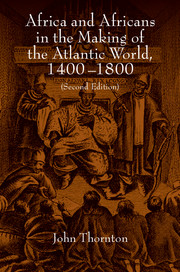Book contents
- Frontmatter
- Contents
- Preface to the second edition
- Abbreviations
- Maps
- Source notes for Maps 1–3
- Africa and Africans in the making of the Atlantic world, 1400–1800
- Introduction
- Part I Africans in Africa
- 1 The birth of an Atlantic world
- 2 The development of commerce between Europeans and Africans
- 3 Slavery and African social structure
- 4 The process of enslavement and the slave trade
- Part II Africans in the New World
- Index
4 - The process of enslavement and the slave trade
Published online by Cambridge University Press: 05 June 2012
- Frontmatter
- Contents
- Preface to the second edition
- Abbreviations
- Maps
- Source notes for Maps 1–3
- Africa and Africans in the making of the Atlantic world, 1400–1800
- Introduction
- Part I Africans in Africa
- 1 The birth of an Atlantic world
- 2 The development of commerce between Europeans and Africans
- 3 Slavery and African social structure
- 4 The process of enslavement and the slave trade
- Part II Africans in the New World
- Index
Summary
Warfare and slavery
We have established so far that Africans were not under any direct commercial or economic pressure to deal in slaves. Furthermore, we have seen not only that Africans accepted the institution of slavery in their own societies, but that the special place of slaves as private productive property made slavery widespread. At the beginning, at least, Europeans were only tapping existing slave markets. Nevertheless, one need not accept that these factors alone can explain the slave trade. There are scholars who contend that although Europeans did not invade the continent and take slaves themselves, they did nevertheless promote the slave trade through indirect military pressure created by European control of important military technology, such as horses and guns. In this scenario – the “gun–slave cycle” or “horse–slave cycle” – Africans were compelled to trade in slaves, because without this commerce they could not obtain the necessary military technology (guns or horses) to defend themselves from any enemy. Furthermore, possession of the technology made them more capable of obtaining slaves, because successful war guaranteed large supplies of slaves.
Hence, through the operation of their control over the “means of destruction,” to use Jack Goody's descriptive term, Europeans were able to influence Africans indirectly. They could direct commerce in ways that helped them and also compel Africans to wage wars that might otherwise not have been waged.
- Type
- Chapter
- Information
- Publisher: Cambridge University PressPrint publication year: 1998

